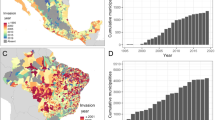Abstract
Conditional autoregressive distributions are commonly used to model spatial dependence between nearby geographic units in disease mapping studies. These distributions induce spatial dependence by means of a spatial weights matrix that quantifies the strength of dependence between any two neighboring spatial units. The most common procedure for defining that spatial weights matrix is using an adjacency criterion. In that case, all pairs of spatial units with adjacent borders are given the same weight (typically 1) and the remaining non-adjacent units are assigned a weight of 0. However, assuming all spatial neighbors in a model to be equally influential could be possibly a too rigid or inappropriate assumption. In this paper, we propose several adaptive conditional autoregressive distributions in which the spatial weights for adjacent areas are random variables, and we discuss their use in spatial disease mapping models. We will introduce our proposal in a multivariate context so that the spatial dependence structure between spatial units is shared and estimated from a sufficiently large set of mortality causes. As we will see, this is a key aspect for making inference on the spatial dependence structure. We show that our adaptive modeling proposal provides more flexible and accurate mortality risk estimates than traditional proposals in which spatial weights for neighboring areas are fixed to a common value.



Similar content being viewed by others
References
Adín A, Martinez-Beneito MA, Botella-Rocamora P, Goicoa T, Ugarte MD (2017) Smoothing and high risk areas detection in space–time disease mapping: a comparison of P-splines, autoregressive and moving average models. Stoch Environ Res Risk Assess 31:403–415. https://doi.org/10.1007/s00477-016-1269-8
Adin A, Lee D, Goicoa T, Ugarte MD (2019) A two-stage approach to estimate spatial and spatio-temporal disease risks in the presence of local discontinuities and clusters. Stat Methods Med Res 28(9):2595–2613. https://doi.org/10.1177/0962280218767975
Besag J (1974) Spatial interaction and the statistical analysis of lattice systems. J R Stat Soc Ser B (Stat Methodol) 36:192–236
Besag J, Kooperberg C (1995) On conditional and intrinsic autoregressions. Biometrika 82(4):733–746
Besag J, York J, Mollié A (1991) Bayesian image restoration, with two applications in spatial statistics. Ann Inst Stat Math 43:1–21. https://doi.org/10.1007/BF00116466
Best NG, Arnold R Arnold, Thomas A, Waller LA, Conlon EM (1999) Bayesian models for spatially correlated disease and exposure data. In: Bayesian statistics, vol 6. Oxford University Press
Botella-Rocamora P, López-Quílez A, Martinez-Beneito MA (2012) Spatial moving average risk smoothing. Stat Med 32:2595–2612. https://doi.org/10.1002/sim.5704
Botella-Rocamora P, Martinez-Beneito MA, Banerjee S (2015) A unifying modeling framework for highly multivariate disease mapping. Stat Med 34(9):1548–1559. https://doi.org/10.1002/sim.6423
Brezger A, Fahrmeir L, Hennerfeind A (2007) Adaptive Gaussian Markov random fields with applications in human brain mapping. Appl Stat 56(3):327–345
Carter CK, Kohn R (1996) Markov chain monte carlo in conditionally gaussian state space models. Biometrika 83(3):589–601
Congdon P (2008) A spatially adaptive conditional autoregressive prior for area health data. Stat Methodol 5:552–563
Denison DG, Holmes CC (2001) Bayesian partitioning for estimating disease risk. Biometrics 57:143–149
Duncan EW, White NM, Mengersen K (2017) Spatial smoothing in bayesian models: a comparison of weights matrix specifications and their impact on inference. Int J Health Geogr 16(1):47. https://doi.org/10.1186/s12942-017-0120-x
Earnest A, Morgan G, Mengersen K, Louise R, Richard S, Beard J (2007) Evaluating the effect of neighbourhood weight matrices on smoothing properties of conditional autoregressive (CAR) models. Int J Health Geogr 6:54
Geman S, Geman D (1984) Stochastic relaxation, Gibbs distribution and the Bayesian restoration of images. IEEE Trans Pattern Anal Mach Intell 6:721–741
Green P, Richardson S (2002) Hidden Markov models and disease mapping. J Am Stat Assoc 97(460):1–16
Knorr-Held L, Raßer G (2000) Bayesian detection of clusters and discontinuities in disease maps. Biometrics 56(13–21):2045–2060
Kuhnert P (2003) New methodology and comparisons for the analysis of binary data using Bayesian and tree based methods
Lang S, Fronk EM, Fahrmeir L (2002) Function estimation with locally adaptive dynamic models. Comput Stat 17(4):479–499
Lawson AB (2018) Bayesian disease mapping: hierarchical modeling in spatial epidemiology, 3rd edn. CRC Press, Boca Raton
Leroux BG, Lei X, Breslow N (1999) Estimation of disease rates in small areas: a new mixed model for spatial dependence. Statistical models in epidemiology, the environment, and clinical trials, pp 135–78
Lu H, Carlin BP (2005) Bayesian areal Wombling for geographical boundary analysis. Geogr Anal 35:265–285
Lu H, Reilly CS, Banerjee S, Carlin BP (2007) Bayesian areal Wombling via adjacency modelling. Environ Ecol Stat 14:433–452
Ma H, Carlin BP (2007) Bayesian multivariate areal Wombling for multiple disease boundary analysis. Bayesian Anal 2(2):281–302
Ma H, Carlin BP, Banerjee S (2010) Hierarchical and joint site-edge methods for medicare hospice service region boundary analysis. Biometrics 66:355–364
MacNab YC (2018) Some recent work on multivariate Gaussian Markov random fields. TEST 27(3):497–541
MacNab YC, Kmetic A, Gustafson P, Sheps S (2006) An innovative application of Bayesian disease mapping methods to patient safety research: a Canadian adverse medical event study. Stat Med 25:3960–3980
Martinez-Beneito MA, Botella Rocamora P (2019) Disease mappping: from foundations to multidimensional modeling. CRC Press, Boca Raton
Raftery AE, Banfield JD (1991) Stopping the Gibbs sampler, the use of morphology, and other issues in spatial statistics. Ann Inst Stat Math 43:32–43 (discussion of Besag et al.)
Richardson S, Thomson A, Best N, Elliot P (2004) Interpreting posterior relative risk estimates in disease-mapping studies. Environ Health Perspect 112(9):1016–1025
Rue H, Held L (2005) Gaussian Markov random fields: theory & applications. CRC Press, Boca Raton
Spiegelhalter DJ, Best NG, Carlin BP, Van Der Linde A (2002) Bayesian measures of model complexity and fit. J R Stat Soc Ser B (Stat Methodol) 64:583–641. https://doi.org/10.1111/1467-9868.00353(with discussion)
Zurriaga O, Vanaclocha H, Martínez-Beneito MA, Botella Rocamora P (2008) Spatio-temporal evolution of female lung cancer mortality in a region of Spain: is it worth taking migration into account? BMC Cancer 8(35):1. https://doi.org/10.1186/1471-2407-8-35
Acknowledgements
The authors acknowledge the support of the research Grant PI16/01004 (co-funded with FEDER grants) of Instituto de Salud Carlos III and the predoctoral Contract UGP-15-156 of FISABIO.
Author information
Authors and Affiliations
Corresponding author
Ethics declarations
Conflict of interest
The authors declare that they have no conflict of interest.
Additional information
Publisher's Note
Springer Nature remains neutral with regard to jurisdictional claims in published maps and institutional affiliations.
Electronic supplementary material
Below is the link to the electronic supplementary material.
Rights and permissions
About this article
Cite this article
Corpas-Burgos, F., Martinez-Beneito, M.A. On the use of adaptive spatial weight matrices from disease mapping multivariate analyses. Stoch Environ Res Risk Assess 34, 531–544 (2020). https://doi.org/10.1007/s00477-020-01781-5
Published:
Issue Date:
DOI: https://doi.org/10.1007/s00477-020-01781-5




